by Kristine Schumcker, HCHM Curator
This is the last in our month long focus on #thisplacematters celebrating Historic Preservation. This post highlights a different kind of building – not a physical building, but a building of a better community. Each of these women were early pioneers in health care in Harvey County.
These women dedicated their lives to the health of the Newton community. Their work provided the foundation for several medical and health services we take for granted today. From a public nurse assisting with immunizations and bringing health information to those in need to it to building hospitals and overseeing the operations.
Deaconesses. Doctors and Hospitals
Two of the women were closely involved in the building and overseeing of Newton’s two hospitals; Sister Frieda Kauffman and Dr. Lucene Axtell.
Dr. Lucena Axtell
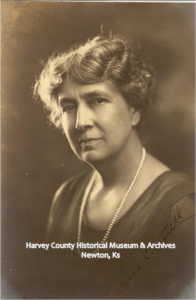
Dr. Lucena Axtell
Lucena was one of two women to graduate from the College of Physicians and Surgeons in in Kansas City in 1897. Dr. Anna Perkins, also from Newton was the other. Following her graduation, she resumed management of the hospital and also set up a private practice.
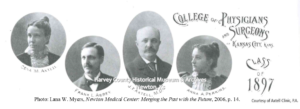
Together with her husband, Dr. John Axtell, opened Axtell Christian Hospital in 1887. The first hospital in Newton, Ks.
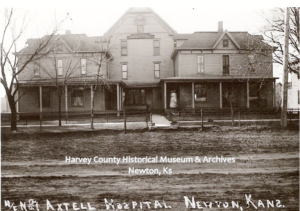
Her daughter Marian Axtell Hanna later recalled:
“Years after she stopped practicing . . . people would come up to her and say, “Oh, Dr. Lucena, surely you remember me. I was so sick and doctor thought that I would surely not live. But you came and stood beside me and held me by the hand and it made me feel so much better.” That was the phrase that always was reiterated, “You held me by the hand and I felt so much better.” daughter Marian Axtell Hanna
Sister Frieda Kauffman
On May 27, 1942, Sister Frieda Kaufman received the Honorary Degree of Doctor of Humane Letters from Bethel College for her lifelong work as a deaconess and ‘sister-in-charge’ of the Bethel Deaconess Home and Hospital in Newton, Ks. She was the first Mennonite woman to receive an honorary degree from a Mennonite institution of higher learning.
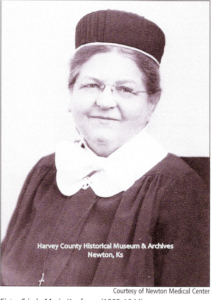
Born in Germany many of her early teachers were Lutheran Deaconesses and Catholic nuns. They had a profound impact on young Frieda. At the age of 8, Frieda with her family migrated to the U.S. arriving in Halstead Ks on July 2, 1892. As she grew up in Halstead, her childhood affinity with the deaconess and nuns did not diminish. She later recalled “the desire of her heart to become a sister did not disappear” as she got older. In 1902, she began the first step to her goal when she began at training the Interdenominational Deaconess Home & Hospital in Cincinnati. She returned to Kansas ready to serve.
On June 11, 1908, the Bethel Deaconess Home & Hospital, located on south Pine in Newton, was dedicated and the first three ordained Mennonite deaconesses in America were ordained, Sisters Frieda Kaufman, Catherine Voth and Ida Epp. At the age of twenty-five, Sister Frieda was appointed deaconess mother and superintendent of the hospital in addition to her nursing duties. She also taught and oversaw the nurses’ training school at Bethel Deaconess Hospital.
As deaconess mother, Sister Frieda oversaw the day-to-day activities of the hospital. In the early years most of the work at the hospital was performed by the deaconesses. Several were trained RNs, like Sister Frieda, but all helped with housekeeping and laundry.
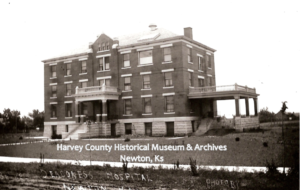
On August 7, 1944, at the age of sixty, Sister Frieda Kaufman passed away due to complications from diabetes and a heart condition. She was buried in the Bethel Sister Family lot at Greenwood Cemetery, Newton Ks.
With almost single minded purpose Sister Frieda Kaufman became a deaconess and spent the rest of her life encouraging other women to join her in the work. She enjoyed people, which contributed to her success as a nurse. She could have been a nurse without becoming a deaconess. She chose to become a deaconess — she saw it as a way of life.
Public Health
This past year we have learned of the importance of public health. Harvey County was an early leader in this area and was one of the first counties in Kansas to establish a Public Health Nurse. Three of the women were pioneers in the area of public health, Sister Anna Penner, Miss Johanna Conway and Miss Lillian Fitzgerald.
The roots for the Public Nurse got it’s start when the Bethel Deaconess Women’s Auxiliary was established on March 22, 1910. One of their many projects was to sponsor a public nurse in Newton.
Sister Anna Gertrude Penner
Sister Anna was ordained in 1916 and went to work at the Bethel Deaconess Hospital. Seeing a need in the community, Sister Anna decided to expand her role into the community and become the first the Public Health Nurse from 1916-1921. In this role, Sister Anna joined a national movement started by Lillian Wald in New York that sought to educate and care for the health of the community and especially the poor.
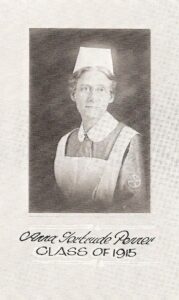 Her duties were varied and went beyond caring for the sick to educating people on proper hygiene and safety. In 1918, the responsibility to finance the Public Nurse program was shifted to the city of Newton.
Her duties were varied and went beyond caring for the sick to educating people on proper hygiene and safety. In 1918, the responsibility to finance the Public Nurse program was shifted to the city of Newton.
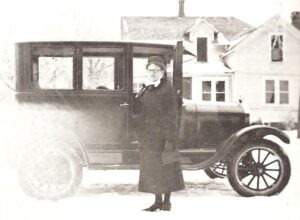
In 1966, Sister Anna was the first Bethel Deaconess to serve for 50 years. Sister Anna Gertrude Penner “quietly departed” on February 22, 1967. She is buried in Greenwood Cemetery along with the other Bethel Deaconesses.
Miss Johann Conway
At the same time, a group of women at St. Mary’s Catholic Church became concerned about the conditions of the “Mexican Camps.” One of the early leaders was Miss Johanna Conway who served as one of seven directors for the “Public Health Service.” Goals of the committee included teaching English and needed skills for future employment including “industrial work and sanitation lines of work.”
In October, the Evening Kansan Republican reported “under the able leadership of Miss Jo” a “band of willing” women spent two afternoons each week “teaching both old and young Mexicans those things which they ought to know but do not know.
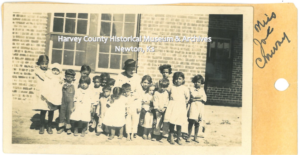
Miss Johann was born in Ohio and came to Newton in 1895 where she lived with her brother and sister. She dedicated her life to providing help and education to the Mexican community in Newton.
Her obituary in the October 5, 1929 Evening Kansan Republican concluded;
“A devout member of the Catholic church, a pioneer worker in St Mary’s parish. . . . She was a leader and organizer in humanitarian work of the community. . . . Her welfare work with the Mexican settlement . . . [where] she has been working assiduously until her illness, a work that cannot be measured on this earth.”
Miss Lillian Fitzgerald
Miss Lillian Fitzpatrick also focused her work in Newton on the Mexican community. In the early 1920s, she worked as a “City Health Nurse” in Newton, Ks. One important responsibility of the City Nurse was “to see that adequate medical and hospital treatment are secured for all indigent persons.” She was expected to not only be a knowledgeable nurse or health care provider, but also be familiar with local agencies that provide assistance to those in need. The position of city nurse was “supported by public funds or by other means of a public nature.” (Evening Kansan Republican, 22 September 1922.)
One of Miss Lillian’s projects included caring for the Mexican American mothers and children that lived at the ranchito in Newton. She oversaw the building of the Mexican Health Center. Described by the Evening Kansan Republican as “a substantial and adequate building the Santa Fe railroad . . . erected for the public health work among the Mexicans of this camp.”
Vaccines & Well Baby Checks
There were many occasions for all of these women to work together as their goals of a healthy community were the same. Much of the work reported in the Kansan Evening Republican centered around vaccinations and well baby checks for all Harvey County children. Educating young mothers was another priority.
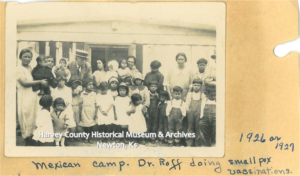
As City Nurse, Miss Lillian worked with doctors and nurses from the two hospitals to provide information and care to new mothers. Education on disease prevention was a strong component for all of their work. Administering the small pox vaccine was another high priority. Miss Lillian assisted Dr. Roff with small pox vaccinations at the “Mexican Camps” in the early 1920s.
In connection with Bethel Deaconess Hospital “Well Baby Clinics” were held at various locations in Newton. The Evening Kansan Republican reported on several clinics held by Miss Lillian in conjunction with Sister Catherine Voth, Bethel Deaconess Hospital, and Miss Lucille Thomas, Red Cross Nurse. In September 1922, a “white baby clinic” was held. Sister Catherine spoke on malnutrition. A meeting for “colored babies and mothers” was held on a separate afternoon.
Each of these women were pioneers in health care, each one dedicating a significant part of their life to the service and care of others, often for little to no pay. Their work formed the foundation for many institutions and services that we have today from the Newton Medical Center to the Harvey County Health Department.
For more on each of these women follow the links in the post to learn their individual stories.
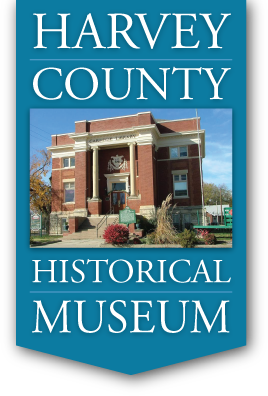
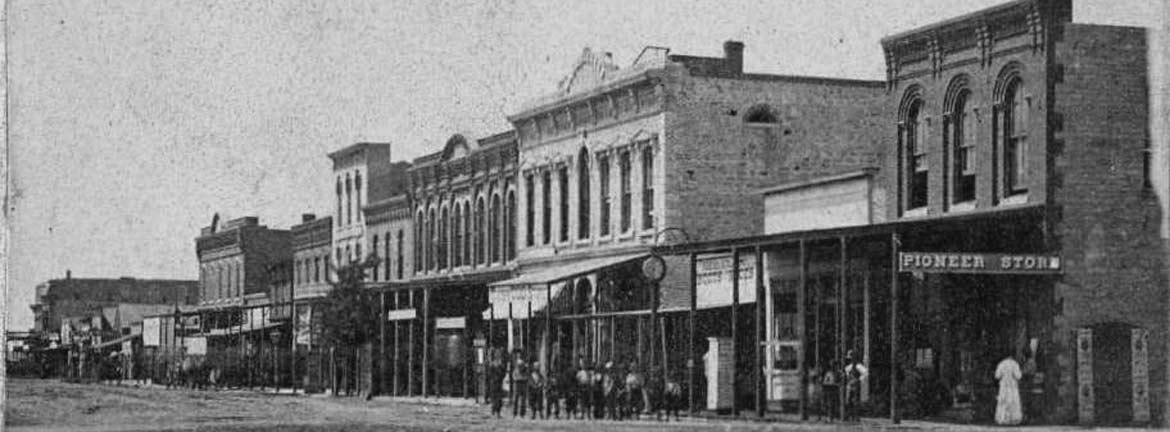
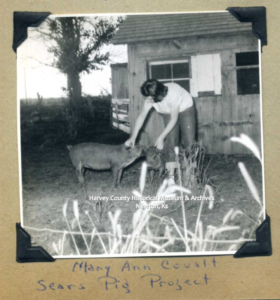












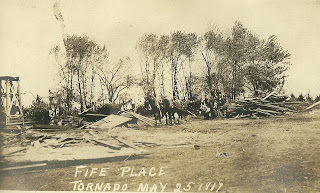
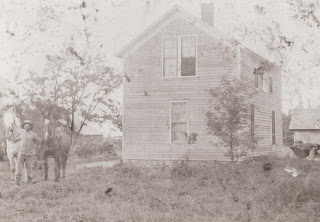


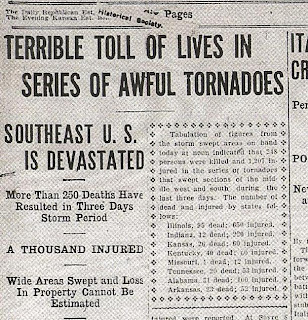
Dewey Faw was the 18 year old boy who was killed. He and his brother Floyd Faw were raised by their Aunt Caroline Coble after their mother died in 1902. Dewey was in the house and he opened the door when he heard the noise. He couldn’t escape. Floyd was one of the lucky ones who made it to the cellar. Four years after the tornado Floyd married his nurse Ivalee Harvey who cared for him while he was recovering from his injuries in the hospital. They were my grandparents.